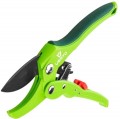Max. cutting diameter
The largest diameter (thickness) of a branch that the tool can handle.
The larger the maximum cut diameter, the more powerful this model, the lower the likelihood that a certain branch will be too tough for the tool. At the same time, note that to ensure high power, long handles and strong blades are needed, which accordingly affects the dimensions, weight and price. Therefore, it is worth choosing according to this parameter with a certain margin, but at the same time, this margin should not be too large.
As for specific figures, a maximum diameter
of 20 mm or less is considered relatively small, but it often turns out to be quite enough for simple work.
21 – 30 mm — the average value,
31 – 40 mm — above average, and in loppers the maximum thickness can
exceed 40 mm.
Blade length
The length of the blades provided in the tool. Usually, the characteristics indicate the working length of the blades — from the tip to the rotary axis.
Both long and short blades have their own specifics, advantages and disadvantages. So, the long length is optimal for working with relatively thin branches: it allows you to cut several of them at a time, and also makes it possible to reach into hard-to-reach places. At the same time, short blades are more compact and provide more force for the same length of handles, which is convenient when working with thick branches. More detailed recommendations on choosing the length of the blades for a specific situation can be found in special sources.
Finger loop
The presence
of a loop for the fingers in the design of the tool. Such a loop is used in one-handed tools: it is usually installed on one of the handles, four fingers are threaded into it, opposing the thumb. Such a device provides additional convenience and reliability in holding the tool (reduces the likelihood of letting it out of hand), and also provides some protection from branches and other foreign objects.

